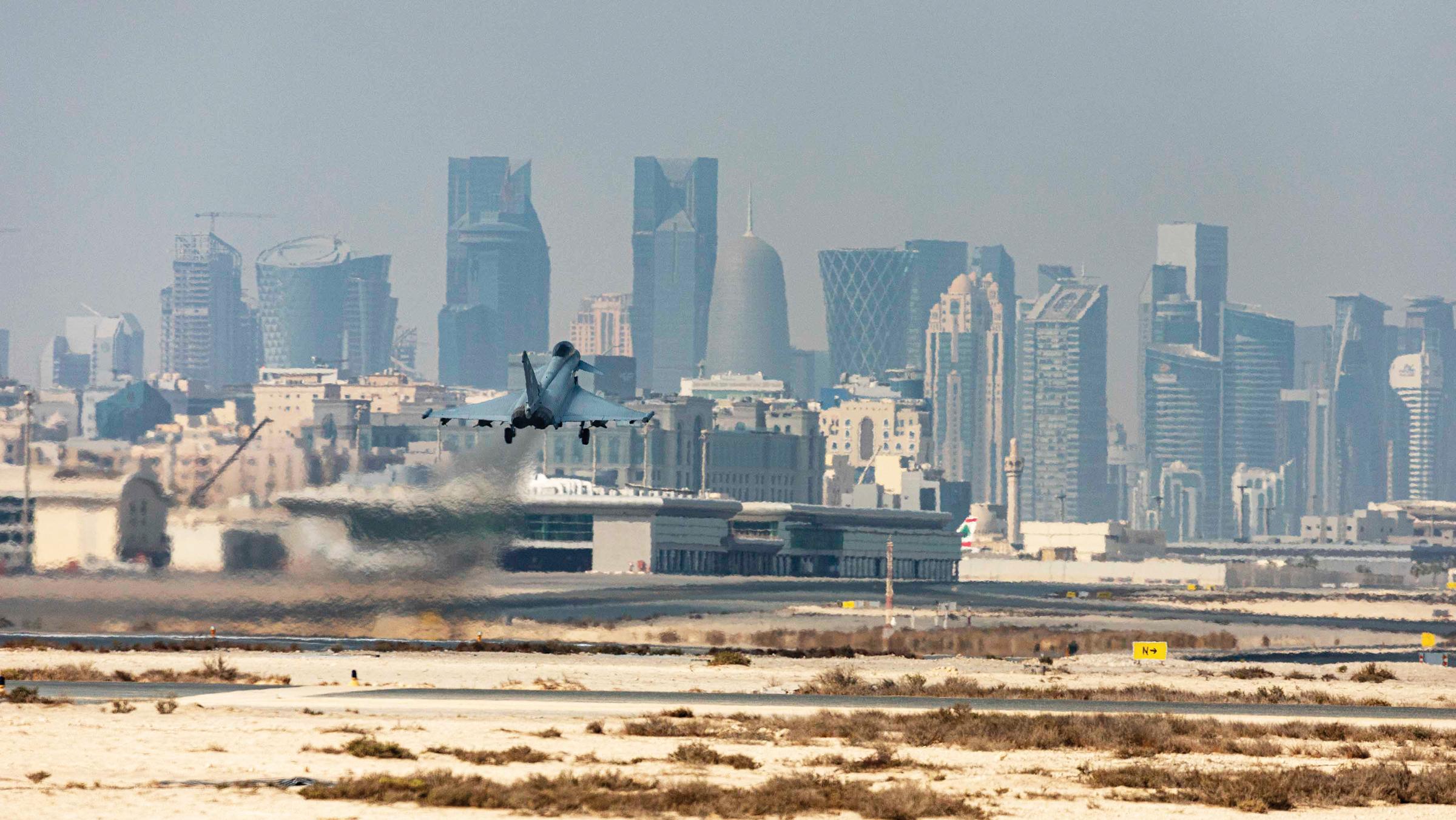
The skyline of Doha will become a familiar sight to aircrews of the joint RAF-QEAF squadron over the coming weeks in their mission to help protect the FIFA World Cup.
Football fans gathering in Qatar during November and December to cheer on their national teams in the FIFA World Cup likely will be blissfully unaware of the enormous security operation that has been developed to protect them.
Part of the Arabian Gulf state’s much enlarged armed forces will be devoted to the event’s security, and they will be supported by a joint UK-Qatari fighter squadron flying the Eurofighter Typhoon through Project Thariyat (Arabic for “Typhoon”), a spinoff from Qatar’s £6 billion ($6.7 billion) acquisition of 24 Eurofighters agreed to in December 2017.
- Qatar received first Eurofighter batch in the summer
- Aerial-refueling service provided through UK-Qatar agreement
Creation of the joint Royal Air Force (RAF) and Qatar Emiri Air Force (QEAF) unit—12 Sqdn.—in 2018, the RAF’s first joint squadron since World War II, is one of several pillars of the UK’s Qatar Air Programs initiative that appears to have helped seal the Typhoon deal and has become central to strengthening UK-Qatari defense ties.
Another pillar of the program is the creation of a second joint squadron, flying BAE Systems Hawk jet trainers, based in the UK but dedicated to training Qatari fighter pilots. The UK also is providing Qatar an air-to-air refueling service with one of its Airbus A330 Voyager Multi-Role Tanker Transport aircraft through a series of six 10-day deployments during 2021 and 2022. That service has allowed QEAF pilots—primarily from Dassault Rafale squadrons—to perform aerial refueling training, as Qatar lacks its own tanker capability.
After qualifying as pilots through Doha’s air force academy, the Qatari pilots complete the UK training system with English language and basic UK flight-training courses to enable them to become comfortable with flying in the UK before they fly the Hawk and the Typhoon.
“These initiatives are part of a deepening UK-Qatari relationship,” Air Cmdre. Richard Yates, the RAF’s senior officer responsible for the Qatar Air Program, tells Aviation Week. “Qatar is an impressive, technically adept and ambitious nation. Its air force has grown quickly, becoming highly technically competent. And, importantly, they like what they see with Typhoon.”
One goal of the joint unit is for Qatari crews to gain 2-3 years of Typhoon flying experience before they receive their first aircraft, Yates adds. This enables Qatar to make operational use of its first batch of Typhoons, which were delivered during the summer, flying them alongside the joint RAF-Qatari unit in support of World Cup security.
In the UK, Qatari Typhoon pilots are trained in the full multirole capabilities of the aircraft, says Sqdn. Ldr. Luke Wilkinson, 12 Sqdn.’s executive officer and a pilot on the unit. Qatari Typhoons are equipped with largely the same weaponry as the RAF’s, including the MBDA advanced short-range air-to-air missile and Meteor air-to-air missiles. The Qatari fighters also carry the Lockheed Martin Sniper targeting pod, which was selected for commonality among the country’s three fighter fleets. The new-build aircraft being delivered to the QEAF are fitted with the European Common Radar System Mk. 0 active, electronically scanned array radar, too, whereas the RAF-owned Typhoons flown by the joint unit carry the mechanically scanned sensor.
Training on the radar is provided through what Wilkinson calls a delta training package provided by BAE Systems, although the radar is operated through the Eurofighter’s human-machine interface in the same way as it is for the mechanically scanned array.
Yates says this UK approach to partnership could be extended to future Eurofighter exports and perhaps eventually the Tempest Future Combat Air System.
The joint squadron has been deployed and is ready for World Cup security operations and training with the QEAF from the newly constructed Al-Dukhan Airbase in the west of Qatar for up to six months. The future of 12 Sqdn. beyond the deployment is under discussion.
Qatari fighter pilots are slated to train with the Hawk squadron in the UK for the next six years, with options for another six years. The RAF will train its own fighter pilots through the unit as well, allowing it to raise training output at a time when it has been facing criticism over pilot training delays. The aerial refueling service may continue too, potentially paving the way for Qatar to invest in its own tanker capability.
Qatar’s Eurofighter order follows contracts with France for the Dassault Rafale and with the U.S. for Boeing’s F-15QA “Ababil” Advanced Eagle. This three-pronged fleet of 96 aircraft is meant to replace Doha’s Dassault Mirage 2000 force, growing the country’s fighter inventory eightfold.





